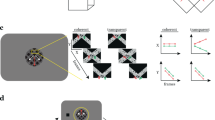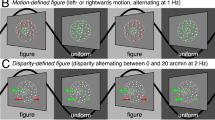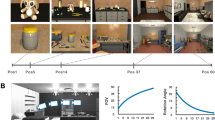Abstract
The identification of visual contours and surfaces is central to visual scene segmentation. One view of image construction argues that object contours are first identified and then surfaces are filled in. Although there are psychophysical and single-unit data to suggest that the filling-in view is correct, the underlying circuitry is unknown. Here we examine specific spike-timing relationships between border and surface responses in cat visual cortical areas 17 and 18. With both real and illusory (Cornsweet) brightness contrast stimuli, we found a border-to-surface shift in the relative timing of spike activity. This shift was absent when borders were absent and could be reversed with relocation of the stimulus border, indicating that the direction of information flow is highly dependent on stimulus conditions. Furthermore, this effect was seen predominantly in 17–18, and not 17–17, interactions. These results demonstrate a border-to-surface mechanism at early stages of visual processing and emphasize the importance of interareal circuitry in vision.
This is a preview of subscription content, access via your institution
Access options
Subscribe to this journal
Receive 12 print issues and online access
$209.00 per year
only $17.42 per issue
Buy this article
- Purchase on Springer Link
- Instant access to full article PDF
Prices may be subject to local taxes which are calculated during checkout





Similar content being viewed by others
References
Cornsweet, T.N. Visual Perception (Academic, New York, 1970).
Mumford, D., Kosslyn, S.M., Hillger, L.A. & Herrnstein, R.J. Discriminating figure from ground: the role of edge detection and region growing. Proc. Natl. Acad. Sci. USA 84, 7354–7358 (1987).
Adelson, E.H. Perceptual organization and the judgment of brightness. Science 262, 2042–2044 (1993).
Anderson, B.L. & Winawer, J. Image segmentation and lightness perception. Nature 434, 79–83 (2005).
Zucker, S.W. in The Encyclopedia of Artificial Intelligence (ed. Shapiro, S.) (John Wiley, New York, 1986).
Elder, J.H. & Zucker, S.W. Evidence for boundary-specific grouping. Vision Res. 38, 143–152 (1998).
Grossberg, S. & Hong, S. A neural model of surface perception: lightness, anchoring, and filling-in. Spat Vis. 19, 263–321 (2006).
Blakeslee, B., Pasieka, W. & McCourt, M.E. Oriented multiscale spatial filtering and contrast normalization: a parsimonious model of brightness induction in a continuum of stimuli including White, Howe and simultaneous brightness contrast. Vision Res. 45, 607–615 (2005).
Dakin, S.C. & Bex, P.J. Natural image statistics mediate brightness 'filling in'. Proc. Biol. Sci. 270, 2341–2348 (2003).
Purves, D., Shimpi, A. & Lotto, R.B. An empirical explanation of the Cornsweet effect. J. Neurosci. 19, 8542–8551 (1999).
Komatsu, H., Kinoshita, M. & Murakami, I. Responses in the retinotopic representation of the blind spot in the macaque V1 to stimuli for perceptual filling-in. J. Neurosci. 20, 9310–9319 (2000).
Pessoa, L., Thompson, E. & Noë, A. Finding out about filling-in: a guide to perceptual completion for visual science and the philosophy of perception. Behav. Brain Sci. 21, 723–748 discussion 748–802 (1998).
Komatsu, H. Surface representation by population coding. Behav. Brain Sci. 21, 761–762 (1998).
Davey, M.P., Maddess, T. & Srinivasan, M.V. The spatiotemporal properties of the Craik-O'Brien-Cornsweet effect are consistent with 'filling-in'. Vision Res. 38, 2037–2046 (1998).
Paradiso, M.A. & Hahn, S. Filling-in percepts produced by luminance modulation. Vision Res. 36, 2657–2663 (1996).
Paradiso, M.A. Visual neuroscience: illuminating the dark corners. Curr. Biol. 10, R15–R18 (2000).
De Weerd, P., Gattass, R., Desimone, R. & Ungerleider, L.G. Responses of cells in monkey visual cortex during perceptual filling-in of an artificial scotoma. Nature 377, 731–734 (1995).
Rossi, A.F., Rittenhouse, C.D. & Paradiso, M.A. The representation of brightness in primary visual cortex. Science 273, 1104–1107 (1996).
Lamme, V.A.F., Rodriguez-Rodriguez, V. & Spekreijse, H. Separate processing dynamics for texture elements, boundaries and surfaces in primary visual cortex of the macaque monkey. Cereb. Cortex. 9, 406–413 (1999).
Hung, C.P., Ramsden, B.M., Chen, L.M. & Roe, A.W. Building surfaces from borders in areas 17 and 18 of the cat. Vision Res. 41, 1389–1407 (2001).
Roe, A.W., Lu, H.D. & Hung, C.P. Cortical processing of a brightness illusion. Proc. Natl. Acad. Sci. USA 102, 3869–3874 (2005).
Bonhoeffer, T., Kim, D-S., Malonek, D., Shoham, D. & Grinvald, A. Optical imaging of the layout of functional domains in area 17 and across the area 17/18 border in cat visual cortex. Eur. J. Neurosci. 7, 1973–1988 (1995).
Bredfeldt, C.E. & Ringach, D.L. Dynamics of spatial frequency tuning in macaque V1. J. Neurosci. 22, 1976–1984 (2002).
Cavanaugh, J.R., Bair, W. & Movshon, J.A. Nature and interaction of signals from the receptive field center and surround in macaque v1 neurons. J. Neurophysiol. 88, 2530–2546 (2002).
DeAngelis, G.C., Freeman, R.D. & Ohzawa, I. Length and width tuning of neurons in the cat's primary visual cortex. J. Neurophysiol. 71, 347–374 (1994).
Ferster, D. & Jagadeesh, B. Nonlinearity of spatial summation in simple cells of areas 17 and 18 of cat visual cortex. J. Neurophysiol. 66, 1667–1679 (1991).
Issa, N.P., Trepel, C. & Stryker, M.P. Spatial frequency maps in cat visual cortex. J. Neurosci. 20, 8504–8514 (2000).
Shoham, D., Hubener, M., Schulze, S., Grinvald, A. & Bonhoeffer, T. Spatio-temporal frequency domains and their relation to cytochrome oxidase staining in cat visual cortex. Nature 385, 529–533 (1997).
Zhou, H., Friedman, H.S. & von der Heydt, R. Coding of border ownership in monkey visual cortex. J. Neurosci. 20, 6594–6611 (2000).
Sceniak, M.P., Ringach, D.L., Hawken, M.J. & Shapley, R. Contrast's effect on spatial summation by macaque V1 neurons. Nat. Neurosci. 2, 733–739 (1999).
Rossi, A.F., Desimone, R. & Ungerleider, L.G. Contextual modulation in primary visual cortex of macaques. J. Neurosci. 21, 1698–1709 (2001).
Reid, R.C. & Alonso, J.M. Specificity of monosynaptic connections from thalamus to visual cortex. Nature 378, 281–284 (1995).
Bullier, J. & Henry, G.H. Neural path taken by afferent streams in striate cortex of the cat. J. Neurophysiol. 42, 1264–1270 (1979).
Givre, S.J., Schroeder, C.E. & Arezzo, J.C. Contribution of extrastriate area V4 to the surface-recorded flash VEP in the awake macaque. Vision Res. 34, 415–428 (1994).
Schyns, P.G. & Oliva, A. From blobs to boundary edges: evidence for time- and spatial-scale–dependent scene recognition. Psychol. Sci. 5, 195–200 (1994).
Burr, D.C. Implications of the Craik-O'Brien illusion for brightness perception. Vision Res. 27, 1903–1913 (1987).
Hung, C.P., Ramsden, B.M. & Roe, A.W. Weakly modulated spike trains: significance, precision and correction for sample size. J. Neurophysiol. 87, 2542–2554 (2002).
Nowak, L.G., Munk, M.H.J., Nelson, J.I., James, A.C. & Bullier, J. Structural basis of cortical synchronization. I. Three types of interhemispheric coupling. J. Neurophysiol. 74, 2379–2400 (1995).
Alonso, J.-M. & Martinez, L.M. Functional connectivity between simple cells and complex cells in cat striate cortex. Nat. Neurosci. 1, 395–403 (1998).
Das, A. & Gilbert, C.D. Topography of contextual modulations mediated by short-range interactions in primary visual cortex. Nature 399, 655–661 (1999).
Siegel, M. & Konig, P. A functional gamma-band defined by stimulus-dependent synchronization in area 18 of awake behaving cats. J. Neurosci. 23, 4251–4260 (2003).
Singer, W. Neuronal synchrony: a versatile code for the definition of relations? Neuron 24, 49–65 111–25 (1999).
Ts'o, D.Y., Gilbert, C.D. & Wiesel, T.N. Relationships between horizontal interactions and functional architecture in cat striate cortex as revealed by cross-correlation analysis. J. Neurosci. 6, 1160–1170 (1986).
Brody, C.D. Correlations without synchrony. Neural Comput. 11, 1537–1551 (1999).
Kinoshita, M. & Komatsu, H. Neural representation of the luminance and brightness of a uniform surface in the macaque primary visual cortex. J. Neurophysiol. 86, 2559–2570 (2001).
MacEvoy, S.P., Kim, W. & Paradiso, M.A. Integration of surface information in primary visual cortex. Nat. Neurosci. 1, 616–620 (1998).
Bravo, M., Blake, R. & Morrison, S. Cats see subjective contours. Vision Res. 28, 861–865 (1988).
De Weerd, P., Sprague, J.M., Raiguel, S., Vandenbussche, E. & Orban, G.A. Effects of visual cortex lesions on orientation discrimination of illusory contours in the cat. Eur. J. Neurosci. 5, 1695–1710 (1993).
Acknowledgements
We wish to thank F.L. Healy for technical assistance, Y.-T. Wu for statistical support and S.-S. Huang for helpful discussions. We also thank E.H. Adelson, G. Kreiman and H. Op de Beeck for helpful comments on an earlier version of the manuscript. The project was supported by US National Institutes of Health grants EY-11744, NEI 5T32 EY-07115, 5T32 DA-07290 and RR-15574, the Whitehall Foundation, Packard Foundation, Yale Brown-Coxe Postdoctoral Fellowship, Taiwan Ministry of Education Five Year Aim for the Top University Plan, and the Taiwan National Science Council and Ministry of Education Outstanding Scholar Fellowship 95-2819-B-010-001.
Author information
Authors and Affiliations
Contributions
C.P.H. and A.W.R. designed the experiments. C.P.H., B.M.R. and A.W.R. carried out the experiments and wrote the paper. C.P.H. analyzed the results.
Corresponding author
Ethics declarations
Competing interests
The authors declare no competing financial interests.
Supplementary information
Supplementary Text and Figures
Supplementary Figures 1-4, Tables 1-5, Methods (PDF 1331 kb)
Rights and permissions
About this article
Cite this article
Hung, C., Ramsden, B. & Roe, A. A functional circuitry for edge-induced brightness perception. Nat Neurosci 10, 1185–1190 (2007). https://doi.org/10.1038/nn1948
Received:
Accepted:
Published:
Issue Date:
DOI: https://doi.org/10.1038/nn1948
This article is cited by
-
A power law study of the edge influence on the perceived filling-in brightness magnitude
Psicologia: Reflexão e Crítica (2019)
-
Luminance gradient at object borders communicates object location to the human oculomotor system
Scientific Reports (2018)
-
V1 neurons respond to luminance changes faster than contrast changes
Scientific Reports (2015)
-
Quality assessment of perceptual color video based on a top-down framework and quaternion
Multimedia Tools and Applications (2014)
-
Neural Mechanism for Sensing Fast Motion in Dim Light
Scientific Reports (2013)



